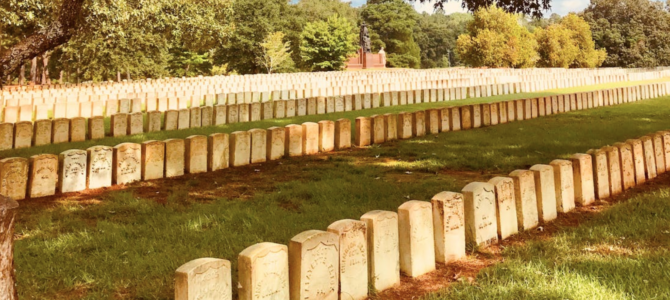
In the bleak midwinter
Frosty wind made moan,
Earth stood hard as iron,
Water like a stone;
Snow had fallen,
Snow on snow,
In the bleak midwinter,
Long ago.
— Christina Rossetti
It was snowing the first time we visited the barren, iron-hard acres of tear-soaked ground at the National Historic Site in rural Georgia. Snow is unusual in this part of the South, and the frosty wind blew hard as we walked the harrowing, sacred site.
In the bleak midwinter 155 years ago this month, my great-great-Uncle Cornelius M. Dearth died here — on the grounds of the Civil War prisoner of war camp in Andersonville, Georgia. He was 22.
Andersonville, also called Camp Sumter, was known as the worst military prison in the war and had the highest death rate of all prisons, even though it was open only 15 months. Some 13,000 soldiers died from disease, putrid water, malnutrition, overcrowding, and exposure. My uncle was the 12,224th man to die at the camp.
The Horrors of the Andersonville Prison Camps
All the prison camps — North and South — were terrible, says Civil War historian Bruce Catton. Andersonville was “merely the worst of a bad lot; North and South alike, they were more lethal than shot and shell.” Overall, 56,000 soldiers died in prisons during the war, nearly10 percent of all Civil War fatalities.
In my family, for too many years, the ultimate sacrifices of our forebears were forgotten. My uncle died of “scorbotus,” the medical term for “scurvy,” a disease caused by starvation and a lack of vitamin C. Exhaustion, anemia, hemorrhages, loss of teeth, and constriction of muscles are all symptoms of the painful disease. His suffering and death more than 700 miles from his Ohio home was recorded by fellow prisoner Dorence Atwater, who volunteered at the prison hospital to record the deaths of all federal prisoners.
The horrors Atwater witnessed at Andersonville led him to keep a secret copy of his register, a list he safely brought with him to Union lines in March 1865. He wrote, as if anticipating our family finally putting the genealogical pieces together:
This Record was originally copied for you because I feared that neither you nor the Government of the United States would ever otherwise learn the fate of your loved ones whom I saw daily dying before me. I could do nothing for them, but I resolved that I would at least try to let you sometime know when and how they died. This at last I am now able to do.
Cornelius Captured at the Battle of Chickamauga
Cornelius was born on the family farm in Ada, a small town in northwest Ohio, the oldest of seven children. He enlisted with the 33rd Ohio Volunteer Infantry Regiment Company K on Sept. 19, 1861, at age 19. His father and brother John also enlisted.
His father, Corp. Noah Dearth of Co. G, 54th Ohio Volunteers, died Oct. 30, 1864, of gunshot wounds he received in the Battle of Kennesaw Mountain. He is buried, also forgotten for too long, at the National Cemetery in Nashville. Cornelius’ brother survived the war.
Two years after enlisting, Cornelius was captured at the Battle of Chickamauga on Sept. 20, 1863. Named for a nearby creek in northwest Georgia, the battle was the most significant Union defeat of the Western Theater. It is likely the captured Cornelius was sent to Belle Island Prison in Richmond.
My young uncle spent the last 15 months of his life in hell. Belle Island Prison, like Andersonville, had cruel overcrowding, no shelter, terrible food, and disease epidemics, including the smallpox outbreak in December 1863, just months after he arrived. At that time, more than 10,500 prisoners were in a space designed for 3,000, according to the Oct. 22, 1863 Richmond Sentinel.
Walt Whitman couldn’t believe what he saw at the camp: Soldiers did not look like men; they looked like creatures or dwindled corpses. After the war, a prisoner recalled Belle Isle as a “nightmare of starvation, disease, and suffering from cold.”
Prisoners Are Moved to the New Andersonville Camp
Then it got worse for Cornelius and thousands like him. In February 1864, the Confederacy began moving prisoners to the new camp at Andersonville, deep in the woods of Georgia. From the beginning, it was a disaster, as the only water for the camp was polluted before it entered the camp, the prisoners had no shelter, and food was scarce in the war-ravaged South.
“As we entered the place, a spectacle met our eyes that almost froze our blood with horror, and made our hearts fail within us,” prisoner Robert H. Kellogg, who entered the camp May 2, 1864, noted. “Before us were forms that had once been active and erect; — stalwart men, now nothing but mere walking skeletons, covered with filth and vermin. Many of our men, in the heat and intensity of their feeling, exclaimed with earnestness: ‘Can this be hell?’ ‘God protect us!’”
Terrifying as it was contemplating life — and death — on the hallowed prison grounds, nothing prepared us for the bleak heartbreak of the cemetery. Rows and rows of white gravestones etched with the Union shield were lined next to each other, barely an inch apart.
The graves were crowded together because the dead were not buried with ceremony and song, but laid body-to-body in trenches. So many men were dying every day that individual burials were impossible. Trenches were dug and bodies tossed in, as many as 100 the December my uncle died. One thousand tears couldn’t ease my brokenness that day.
We found my uncle’s gravestone, put our flowers next to it, and played a recording of taps. Then we wept.
We Will Never Forget
The horror is real, but I am grateful for the fastidious if gruesome recording of the death facts. Because of the work of Pvt. Atwater and Clara Barton, some 95 percent of the prisoner graves at Andersonville — all 13,000 of them — are marked.
Cornelius’ youngest sister Mathilda, who was 7 when he died, was an old woman when my mother met her. She had named her son, my great-grandfather, Cornelius, and passed onto us one of her handmade quilts. I think of that precious quilt and the warmth it still gives as I think of her long-lost brother of the Grand Army of the Republic.
It is odd to live in the Deep South with Yankee roots and Union soldier ancestry. But I am proud of Cornelius Dearth and his service, and his father’s service, to a noble cause. This year I will join thousands of volunteers in the National Wreaths Across America campaign on Saturday, Dec. 14, as we place the evergreen wreaths in more than 1,600 locations on graves of veterans who have served this nation since the American Revolution.
It’s a nearly four-hour drive on some rural roads in the middle of the holiday season, but every mile I drive in the comfort of a warm car, I will remember the excruciating sacrifice of this young man I never met, who fought for others’ freedom and suffered so horribly for it.
It is a melancholy message for a month of holidays, but it is an important one. I gladly share the National Wreaths’ campaign motto: We will never forget.









